Two UC teams in Australasian autonomous robot competition
New Zealand will be represented by two University of Canterbury (UC) teams at the Australasian autonomous robot search and rescue competition in Melbourne on Friday.
The theme for this year's competition run by National Instruments Australia is search and rescue, so the tasks the robots must perform a simulated a search and rescue operation.
Each team that successfully takes part this weekend will keep the $27,000 of hardware and software given to them to design their robots. The winning team will also receive $3000 cash, supervising UC lecturer Allan McInnes said today.
UC’s teams are Cube, based in the electrical and computer engineering department, and Norm 2.0, based out of the mechanical engineering department.
Cube team leader Alex Lippitt said their robot could drive from the home location to a rescue zone. It had to navigate around obstacles with the help of ultrasonic and infrared sensors.
``Once we get to the rescue zone we use a camera to detect the victims. The victims are represented by coloured cubes. When the robot detects a cube it drives to it and picks it up with an arm and places it on a tray,’’ Lippitt said.
Once it has picked up both ‘victims’ it then delivers them to the helipad zone. Over the course of the project, each team member has spent about eight hours week for the last seven months improving their robot.
This year the competition has involved 24 teams from universities around Australia and New Zealand. Each team has designed, built, and programmed their robots to operate independently, without needing any guidance.
